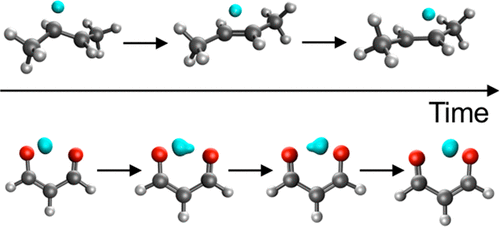当前位置:
X-MOL 学术
›
Acc. Chem. Res.
›
论文详情
Our official English website, www.x-mol.net, welcomes your
feedback! (Note: you will need to create a separate account there.)
Direct Dynamics with Nuclear–Electronic Orbital Density Functional Theory
Accounts of Chemical Research ( IF 16.4 ) Pub Date : 2021-11-02 , DOI: 10.1021/acs.accounts.1c00516 Zhen Tao 1 , Qi Yu 1 , Saswata Roy 1 , Sharon Hammes-Schiffer 1
Accounts of Chemical Research ( IF 16.4 ) Pub Date : 2021-11-02 , DOI: 10.1021/acs.accounts.1c00516 Zhen Tao 1 , Qi Yu 1 , Saswata Roy 1 , Sharon Hammes-Schiffer 1
Affiliation

|
Direct dynamics simulations of chemical reactions typically require the selection of a method for generating the potential energy surfaces and a method for the dynamical propagation of the nuclei on these surfaces. The nuclear–electronic orbital (NEO) framework avoids this Born–Oppenheimer separation by treating specified nuclei on the same level as the electrons with wave function methods or density functional theory (DFT). The NEO approach is particularly applicable to proton, hydride, and proton-coupled electron transfer reactions, where the transferring proton(s) and all electrons are treated quantum mechanically. In this manner, the zero-point energy, density delocalization, and anharmonicity of the transferring protons are inherently and efficiently included in the energies, optimized geometries, and dynamics.
中文翻译:

具有核电子轨道密度泛函理论的直接动力学
化学反应的直接动力学模拟通常需要选择一种生成势能面的方法和一种用于核在这些表面上动态传播的方法。核-电子轨道 (NEO) 框架通过使用波函数方法或密度泛函理论 (DFT) 在与电子相同的水平上处理特定核来避免这种 Born-Oppenheimer 分离。NEO 方法特别适用于质子、氢化物和质子耦合电子转移反应,其中转移的质子和所有电子都经过量子力学处理。以这种方式,转移质子的零点能量、密度离域和非谐性本质上并有效地包含在能量、优化的几何形状和动力学中。
更新日期:2021-11-16
中文翻译:

具有核电子轨道密度泛函理论的直接动力学
化学反应的直接动力学模拟通常需要选择一种生成势能面的方法和一种用于核在这些表面上动态传播的方法。核-电子轨道 (NEO) 框架通过使用波函数方法或密度泛函理论 (DFT) 在与电子相同的水平上处理特定核来避免这种 Born-Oppenheimer 分离。NEO 方法特别适用于质子、氢化物和质子耦合电子转移反应,其中转移的质子和所有电子都经过量子力学处理。以这种方式,转移质子的零点能量、密度离域和非谐性本质上并有效地包含在能量、优化的几何形状和动力学中。









































 京公网安备 11010802027423号
京公网安备 11010802027423号